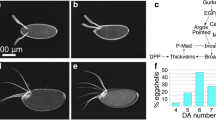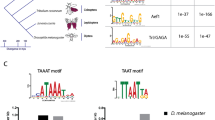Abstract
We have characterized at the molecular level the zerknüllt (zen) region of the Drosophila subobscura Antennapedia complex. The sequence comparison between D. subobscura and D. melanogaster shows an irregular distribution of the conserved and diverged regions, with the homeobox and a putative activating domain completely conserved. Comparisons of the promoter sequence and pattern of expression of the gene during development suggest that the regulation of zen has been conserved during evolution. The conservation of zen expression in a subpopulation of the polar cells indicates the existence of an important role in such cells. We describe a transitory segmented pattern of expression of zen in both species, suggesting the existence of interactions with a pair rule gene. Some indirect clues indicate that the z2 gene might be absent from the D. subobscura genome. A chromosome walk initiated to reach the proboscipedia gene of D. subobscura reveals that the distance between pb and zen is at least four times the one described for D. melanogaster and for D. pseudoobscura. Finally, we present cytological evidence showing that the ANT-C is inverted in D. subobscura as compared to D. melanogaster.
Similar content being viewed by others
References
Akam M (1989) Hox and HOM: homologous gene clusters in insects and vertebrates. Cell 57:347–349
Arndt K, Fink GR (1986) GCN4 protein, a positive transcription factor in yeast, binds general control promoters at all 5′ TGACTC sequences. Proc Natl Acad Sci USA 83:8516–8520
Artero RD, Akam M, Perez-Alonso M (1992) Oligonucleotide probes detect splicing variants in situ in Drosophila embryos. NAR 20:5678–5690
Atherton DY, Gall J (1972) Salivary gland squashes for in situ nucleic acids hybridisation studies. DIS 49:131–133
Beeman RW, Jeffrey JS, Brown SJ, Denell RE (1993) Structure and function of the homeotic gene complex (HOM-C) in the beetle, Tribolium castaneum. Bioessays 15:439–444
Berleth T, Burri M, Thoma G, Bopp D, Richstein S, Frigerio G, Noll M, Nüsslein-Volhard C (1988) The role of localisation of bicoid RNA in organising the anterior pattern of the Drosophila embryo. EMBO J 7:1749–1756
Boncinelli E, Acampora D, Pannese M, Desposito M, Somma R, Gaudino G, Stornaiuolo A, Cafiero M, Faiella A, Simeone A (1989) Organisation of human class-I homeobox genes. Genone 31:745–756
Bürglin T, Ruvkun G (1993) The Caenorhabditis elegans homeo-box gene cluster. Current Opinion Genet Dev 3:615–620
Cribbs DL, Pultz MA, Johnson D, Mazzulla M, Kaufman TC (1992) Structural complexity and evolutionary conservation of the Drosophila homeotic gene proboscipedia. EMBO J 11:1437–1499
Dekker E, Pannese J, Houtzager M, Boncinelli E, Durston E (1992) A colinearity in the Xenopus-laevis Hox-2 complex. Mech Dev 40:3–12
Doyle HJ, Kraut R, Levine M (1989) Spatial regulation of zen—a dorsal-ventral patterning gene in Drosophila. Genes Dev 3:1518–1533
Driggers PH, Ennist DL, Gleason SL, Mak WH, Marks MS, Levi BZ, Flanagan JR, Appella E, Ozato K (1990) An interferon gregulated protein that binds the interferon-inducible enhancer element of major histocompatibility complex class I genes. Proc Natl Acad Sci USA 87:3743–3747
Duboule D, Dollé P (1989) The structural and functional organization of the murine Hox gene family resembles that of Drosophila homeotic genes. EMBO J 8:1427–1505
Fenerjian MG, Martinez-Cruzado JC, Swimmer C (1989) Evolution of the autosomal chorion cluster in Drosophila. II. Chorion gene expression and sequence comparisons of the s16 and s19 genes in evolutinary diverged species. J Mol Evol 29: 108–125
Frutos R de, Kimura K, Peterson K (1990) In situ hybridisation of Drosophila polythene chromosomes with digoxxigenin-dUTP labelled probes. Methods Mol Cell Biol 2:32–36
Han K, Levine MS, Manley I (1989) Synergistic activation and repression of transcription by Drosophila homeobox proteins. Cell 56:573–583
Heberlein U, Rubin GM (1990) Structural and functional comparisons of the Drosophila virilis and Drosophila melanogaster rough genes. Proc Natl Acad Sci USA 87:5916–5920
Ip YT, Kraut R, Levine M, Rushlow CA (1991) The dorsal morphogen is a sequence-specific DNA-binding protein that interacts with a long-range repression element in Drosophila. Cell 64:439–446
Jiang J, Levine M (1993) Binding affinities and co-operative interactions with bHLH activators delimit threshold responses to the dorsal gradient morphogen. Cell 72:741–752
Jiang J, Cai H, Zhou Q, Levine M (1993) Conversion of a dorsal-dependent silencer into a enhancer, evidence for dorsal core-pressor. EMBO J 12:3201–3209
Jiang J, Rushlow CA, Zhou Q, Small S, Levine M (1992) Individiual dorsal morphogen binding sites mediate activation and repression in the Drosophila embryo. EMBO J 11:3147–3154
Kassis JA, Poole SJ, Wright DK, O'Farrell PH (1986) Sequence conservation in the protein coding and intron regions of the engrailed transcription unit. EMBO J 5:3583–3589
Kassis JA, Desplan C, Wright DK, O'Farrell PH (1989) Evolutionary conservation of homeodomain-binding sites and other sequences upstream and within the major transcription unit of the Drosophila segmentation gene engrailed. Mol Cell Biol 9:4304–4311
Kaufman TC, Seeger MA, Olsen G (1990) Molecular and genetic organisation of the Antennapedia gene complex of Drosophila melanogaster. Adv Genet 27:309–362
Kirov N, Zhelnin L, Shah J, Rushlow C (1993) Conversion of a silencer into a enhancer: evidence for a co-repressor in dorsal mediated repression in Drosophila. EMBO J 12:3193–3199
Maier D, Preiss A, Powell JR (1990) Regulation of the segmentation gene fushi-tarazu has been functionally conserved in Drosophila. EMBO J 9:3957–3966
Mlodzik M, Fjose A, Gehring WJ, (1988) Molecular structure and spatial expression of a homeobox gene from the lab region of the Antennapedia complex. EMBO J 7:2569–2578
Pan D, Courey AJ (1992) The same dorsal binding site mediates both activation and repression in a context-dependent manner. EMBO J 11:1837–1842
Panganiban GEF, Reuter R, Scott MP, Hoffman FM (1990) A Drosophila growth factor homologue, Decapentaplegic, regulates homeotic gene expression within and across germ layers during midgut morphogenesis. Development 110:1041–1050
Perez-Alonso M, Hooper JE, Bermingham JR, Prout M, Rocklein B, Wagenbach M, Edstrom JE, de Frutos R Scott MP (1992) Comparative studies of Drosophila Antennapedia genes. Genetics 132:453–469
Pultz MA, Diederich RJ, Cribbs DL, Kaufman TC (1988) The proboscipedia locus of the Antennapedia Complex: a molecular and genetic analysis. Genes Dev 2:901–920
Randazzo FM Seeger MA, Huss CA, Sweeney MA, Cecil JK, Kaufman TC (1993) Structural changes in the Antennapedia complex of Drosophila pseudoobscura. Genetics 134:319–330
Ray RP, Arora K, Nüsslein-Volhard C, Gelbart WM (1991) The control of cell fate along the dorsal ventral axis of the Drosophila embryo. Development 113:35–54
Rogers S, Wells R, Rechsteiner M (1986) Amino acid sequences common to rapidly degraded proteins: the PEST hypothesis. Science 234:364–368
Ross MH, Tanaka A (1988) Genetic variability in the German cockroach. XII: A third mutant that suggests chromosome 9 carries a highly conserved group of closely linked genes. J Hered 79:439–443
Rushlow C, Doyle H, Hoey T, Levine M (1987a) Molecular characterisation of the zen region of the Antennapedia gene complex in Drosophila. Genes Dev 1:1268–1279
Rushlow C, Frasch, Doyle H, Levine M (1987b) Maternal regulation of zen, a homebox gene controlling differentiation of dorsal tissues in Drosophila Nature 330:583–586
Sanger F, Nicklen S, Coulson AR (1977) DNA sequencing with chain-termination inhibitors. Proc Natl Acad Sci USA 74:5463–5467
Scott M, Weiner PAJ, Hazelrigg TI, Polisky BA, Pirrotta V, Scalenghe F, Kaufman TC (1983) The molecular organisation of the Antennapedia locus of Drosophila. Cell 35:763–776
Seeger MA, Haffley L, Kaufman TC (1988) Characterisation of amalgam: a member of the immunoglobulin superfamily from Drosophila. Cell 55:589–600
Seeger MA, Kaufman TC (1990) Molecular analysis of the bcd gene from Drosophila pseudoobscura. Identification of conserved domains withit coding and noncoding regions of the bcd messenger RNA. EMBO J 9:2977–2987
Tautz D, Pfeifle C (1989) A non-radioactive method for the localisation of RNAs in Drosophila embryos reveals translational control of the segmentation gene hunchback. Chromosoma 98:81–85
Terol J, Perez-Alonso M, de Frutos R (1991) In situ localisation of the Antennapedia gene on the chromosomes of the nine species of the obscura group. Hereditas 114:131–139
Treier M, Pfeifle C, Tautz D (1989) Comparison of the gap segmentation gene hunchback between Drosophila melanogaster and Drosophila virilis reveals novel modes of evolutionary change. EMBO J 8:1517–1525
Weiner A, Scott M, Kaufman TC (1984) A molecular analysis of fushi-tarazu, a gene in D. melanogaster that encodes a product affecting segment number and cell fate. Cell 37:843–851
Wilde CD, Akam M (1987) Conserved se1uence elements in the 5′ region of the Ultrabithorax transcription unit. EMBO J 6: 1393–1401
Author information
Authors and Affiliations
Rights and permissions
About this article
Cite this article
Terol, J., Perez-Alonso, M. & de Frutos, R. Molecular characterization of the zerknüllt region of the Antennapedia complex of D. subobscura . Chromosoma 103, 613–624 (1995). https://doi.org/10.1007/BF00357688
Received:
Revised:
Accepted:
Issue Date:
DOI: https://doi.org/10.1007/BF00357688




